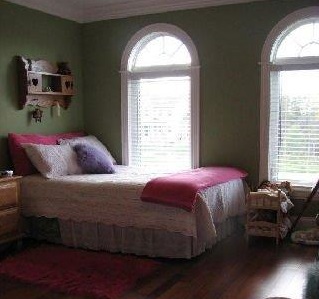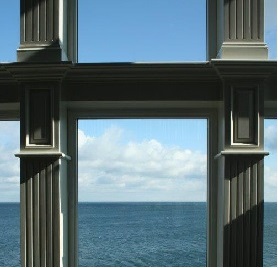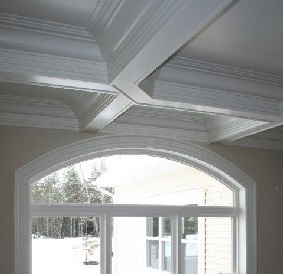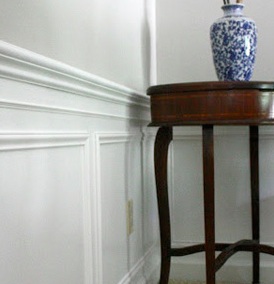Molding Ideas and Terminology
Trimming the interior of a room is one of the easiest and most cost-effective ways to add elegance and character. Because it is part of the room itself, molding improves the feeling of quality and craftsmanship in any room, home, or building.
Is it Moulding or Molding?
Both are correct! Moulding with a 'u' is the Canadian (or British) spelling, just like in Canada we spell harbour with a u as well. Molding is the more common American spelling, used throughout most of the USA. But you will see Molding in Canada now and then, and the word Moulding in the USA as well. So let's call them both international! Note: as a nod to friends in different areas, we use both terms interchangeably on this website.
Common Moldings & Their Uses
 Whether you are in Canada or the United States, here are some of the most common types of moulding, their uses, and benefits:
Whether you are in Canada or the United States, here are some of the most common types of moulding, their uses, and benefits:
• MDF molding (made from medium-density fiberboard) is economical to use and come primed and ready for paint, delivering great results with a minimum of fuss.
• Crown molding is installed at the top of the wall along the ceiling. Crown molding comes in many different sizes and a wide variety of styles from simple and elegant to elaborate.
• Baseboard molding, running along the bottom of walls, can be made from a flat board topped with a narrow base cap, or bought as a single piece with the top edge routed with a decorative profile.
• Quarter-round (also called shoe molding) is used at the seam between the baseboard and the flooring.
• Chair rail goes flat against wall, usually around 24 to 36 inches high - about the height of a chair, though sometimes it's better to put it lower (for lower ceilings).
• Beadboard or bead molding is used to create wainscoting along the lower portion of walls. Beadboard is typically topped with decorative trim.
• Colonial trim is used most often in casings around windows and doors.
These are some of the more popular types of molding.
Molding to Make a Room Warmer
 Decorative molding can quickly transform the interior of a room like little else. For example, large rooms with high ceilings can look cavernous and cold. But using wide crown moldings across the top, with baseboard molding and door and window casing, break up the monotony of the room and create a cozy, textured feeling of warmth and quality.
Decorative molding can quickly transform the interior of a room like little else. For example, large rooms with high ceilings can look cavernous and cold. But using wide crown moldings across the top, with baseboard molding and door and window casing, break up the monotony of the room and create a cozy, textured feeling of warmth and quality.
Including a lot of decorative trim was once how most builders worked. While the practice became less common towards the end of the last century, it has been making a comeback as builders realize how much molding does to improve the ambience and feeling of quality in a room. And fortunately, it's easy to retrofit moldings to a room, using MDF moldings for a quick and pleasing result.
What Can Molding Do for a Room?
 Molding can do a lot more than just be pretty ornamentation, you can use molding to add height, to bring balance to a space, to create flow, and fix any number of different space and visual challenges in a room.
Molding can do a lot more than just be pretty ornamentation, you can use molding to add height, to bring balance to a space, to create flow, and fix any number of different space and visual challenges in a room.
Sure, the core purpose of molding is to add a decorative element to a room. But it can do much more. Molding can make a doorway look taller, can make windows look higher, or make a room seem longer. Molding, if properly used, following time-tested rules about space and placement, can make a room seem more balanced and comfortable. It's not always obvious why a room feels that way, but a good builder will know what they did to balance out the space, and make the most of what was there, or to solve problems that the room might otherwise have with height or space.
For Example - Chair Rails: What Height it Right?
 And just to prove that not all commonly used rules are right... here is one that is often done wrong! If you ask most builders how high a chair rail should be, most will say 30 to 36 inches, or they’ll measure the back of a chair and tell you to match that so the chair doesn't scrape the wall. But that rule of thumb was developed in a time when ceilings were commonly 12 feet or higher. The truth is that the use of a chair rail is more about decoration than it is function. And that with ceilings in most homes being around 8 feet, a chair rail that rises only to 24-30 inches will do more to make the room look taller.
And just to prove that not all commonly used rules are right... here is one that is often done wrong! If you ask most builders how high a chair rail should be, most will say 30 to 36 inches, or they’ll measure the back of a chair and tell you to match that so the chair doesn't scrape the wall. But that rule of thumb was developed in a time when ceilings were commonly 12 feet or higher. The truth is that the use of a chair rail is more about decoration than it is function. And that with ceilings in most homes being around 8 feet, a chair rail that rises only to 24-30 inches will do more to make the room look taller.
Have a molding project in mind? Or need molding for your next building? Give Moulding Warehouse a call! We'll be happy to provide you with great advice - and great molding prices.



 Whether you are in Canada or the United States, here are some of the most common types of moulding, their uses, and benefits:
Whether you are in Canada or the United States, here are some of the most common types of moulding, their uses, and benefits: Decorative molding can quickly transform the interior of a room like little else. For example, large rooms with high ceilings can look cavernous and cold. But using wide crown moldings across the top, with baseboard molding and door and window casing, break up the monotony of the room and create a cozy, textured feeling of warmth and quality.
Decorative molding can quickly transform the interior of a room like little else. For example, large rooms with high ceilings can look cavernous and cold. But using wide crown moldings across the top, with baseboard molding and door and window casing, break up the monotony of the room and create a cozy, textured feeling of warmth and quality.  Molding can do a lot more than just be pretty ornamentation, you can use molding to add height, to bring balance to a space, to create flow, and fix any number of different space and visual challenges in a room.
Molding can do a lot more than just be pretty ornamentation, you can use molding to add height, to bring balance to a space, to create flow, and fix any number of different space and visual challenges in a room. And just to prove that not all commonly used rules are right... here is one that is often done wrong! If you ask most builders how high a chair rail should be, most will say 30 to 36 inches, or they’ll measure the back of a chair and tell you to match that so the chair doesn't scrape the wall. But that rule of thumb was developed in a time when ceilings were commonly 12 feet or higher. The truth is that the use of a chair rail is more about decoration than it is function. And that with ceilings in most homes being around 8 feet, a chair rail that rises only to 24-30 inches will do more to make the room look taller.
And just to prove that not all commonly used rules are right... here is one that is often done wrong! If you ask most builders how high a chair rail should be, most will say 30 to 36 inches, or they’ll measure the back of a chair and tell you to match that so the chair doesn't scrape the wall. But that rule of thumb was developed in a time when ceilings were commonly 12 feet or higher. The truth is that the use of a chair rail is more about decoration than it is function. And that with ceilings in most homes being around 8 feet, a chair rail that rises only to 24-30 inches will do more to make the room look taller.